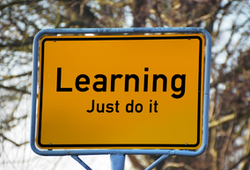 Learning. Just do it. Learning. Just do it. PlainLanguageAcademies.com Newsletter 23-01 Ready for 2023 The Plain Language Academies team is looking to the future with excitement and energy. Our French Academy, clairetsimple, is offering its first course; the much-anticipated ISO standard is coming; and, the PLAIN 2023 Conference, Connecting Cultures – building bridges with clear communication in Buenos Aries, Argentina, in September. We are constantly identifying new training needs and creating courses to address them. Let us guide you on your 2023 plain language journey. Welcome to l'Académie du langage clair et simple We welcome the first course from our French Academy, with the award-winning plain language advocates and trainers Chantale Audet and Amélie Bourret, autrementdit.ca. The Plain Language Academies are pleased to announce the new clair et simple’s online training course in French on Zoom. The training is entitled Writing Clearly to be Understood on First Reading. Students will learn what health literacy is and how to address and reinforce it with plain language. · For more information and to register on Eventbrite: https://bit.ly/3xyOfHc. · To email the L’Académie du langage clair et simple: academie@autrementdit.ca. · Visit their page on PLA: Académie du langage clair et simple . ********************************************************** Bienvenue à l'Académie du langage clair et simple L’Académie du langage clair et simple est heureuse d’annoncer la tenue d’une formation en ligne en français sur Zoom. La formation est intitulée Rédiger clairement pour être compris à la première lecture. Dans cette formation, vous apprendrez ce qu’est la littératie en santé et verrez comment la prendre en compte et la renforcer avec le langage clair et simple. Cette formation est divisée en quatre parties : · Le contexte d’information d’aujourd’hui · Qu’est-ce que la littératie et la littératie en santé ? · Le langage clair et simple · Les 6 étapes pour écrire en langage clair et simple: volet pratique composé d’exercices La formation est répartie sur 2 journées : · Mardi 25 avril 2023, de 9 h à 11 h 30 · Jeudi 27 avril 2023, de 9 h à 11 h Pour obtenir plus d’information et pour vous y inscrire sur Eventbrite :https://bit.ly/3xyOfHc. Pour contacter l’équipe de l’Académie du langage clair et simple: academie@autrementdit.ca Details are on the PLA website New help creating clear design online Our new course, Clear Digital Design is available now. It’s for non-designers who find themselves needing to make design-related decisions. Annie and Liezl, heyplainjane.com, will help strengthen your clear design skills to prepare you for working on your next project. Find our more from them or email PLA. Register here. Pick the PLA courses that will get you to your destination We are expanding our base of Core and Advanced courses to meet increasing knowledge and skill demands. Check PLA 2023 Calendar to find courses just for you. We are here to help. Get in touch if you have questions. Looking forward to connecting, PLA Team PS Our newsletters will now be posted as blogs. PLA.com Newsletter Blog 23-01 kate@plainlanguageacademy.com Email to unsubscribe
0 Comments
More languages, more accessibility
English courses with Kate and the Plain Language Academy team continue to expand at plainlanguageacademy.moodlecloud.com/. Want to study in French? Chantale Audet and Amélie Bourret, from Autrement dit, are soon opening the doors to our French Academy, Clair et Simple. Wish to study plain language in Spanish? Romina Marazzato Sparano, from Language Compass, has set up our Spanish Academy at educlaro.moodlecloud.com. Join in the learning, choose the language you prefer, and enjoy. Learn to be a strategic plain language planner The first Plain Language as a Strategic Priority Advanced course was a huge success. One student wrote: “Thank you for a fantastic course. This perspective on Plain Language is quite unique. I’ve learnt a lot.’’ Now the course is back for a second offering of advice and practice on how to integrate plain language into your organization through strategic planning. Sarah Slabbert and Nadja Green, Plain Language Institute, SA, bring a wealth of experience and will share it in the course materials, activities and discussions. The course equips you with a portfolio of planning documents and skills to implement plain language in your organizations. You can still join in. Register now. Three easy steps to enrol on Moodle All three academies are running on Moodle. You first need your own Moodle account to register and gain access to courses.
Email getintouch@plainlanguageacademy.com or your Academy’s contact if you need help. Welcome/Bienvenue Des nouvelles de l’Académie du langage clair et simple Vos documents sont-ils en langage clair et simple ? Autrement dit vous offre la possibilité de participer à un atelier pratique pour le découvrir. Rien de mieux que de vous pratiquer sur vos propres documents pour poser vous-même un diagnostic. Qui est le public visé par votre communication ? Votre objectif est-il clair ? Comment pouvez-vous améliorer la structure de votre document, la façon de l’écrire et sa présentation visuelle ? Assistez à cet atelier pratique pour savoir comment répondre à toutes ces questions ! Titre : Vos documents sont-ils en langage clair et simple ? Atelier pratique pour faire votre propre diagnostic Animation : Amélie Bourret et Chantale Audet, Autrement dit. Coût : Gratuit Quand : Surveillez les fils PlainLanguageAcademies.com, LinkedIn, et Facebook pour connaître la date exacte. Pour plus d’information : academie@autrementdit.ca Gracieuseté de Plain Language Academies News from Académie du langage clair et simple Are your documents in plain language? Autrement dit gives you the opportunity to participate in a workshop to find out. Nothing better than practicing on your own documents to make an assessment yourself. Who is the target audience for your documents? Is your purpose clear? How can you improve the structure of your document, the way you write it and its visual presentation? Attend this hands-on workshop to find out how to answer all these questions! Title: Are your documents in plain language? Workshop to make your own assessment Workshop facilitators: Amélie Bourret and Chantale Audet, Autrement dit. Cost: Free When: During the International Plain Language Week in October 10-16, 2021 Watch the Plain Language Academies website, LinkedIn and Facebook for the date. For more information: academie@autrementdit.ca An academy within the Plain Language Academies Welcome/Bienvenidos Noticias sobre la Academia de Lenguaje Claro El programa en español de las Academia de Lenguaje Claro abre este otoño con un curso sobre alfabetización en salud. Como se evidencia ante esta nueva realidad de Covid-19, la alfabetización en salud es ahora más importante que nunca. La falta de comprensión y conocimientos sobre la salud lleva a sufrir consecuencias reales. Nuestra Academia de Lenguaje Claro, EduClaro, se ve fortalecida por la diversidad de perspectivas que aportan estudiantes e instructores provenientes de todo Estados Unidos, América Latina y España. ¡Te invitamos a unirte a nuestros cursos! Mantente actualizado en el sitio web de Plain Language Academies, LinkedIn y Facebook. Romina Marazzato Sparano, romina@languagecompass.com An academy within the Plain Language Academies News from Academia de Lenguaje Claro The Spanish program at Plain Language Academies is launching this Fall with its Health Literacy course. As we continue to navigate the new Covid-19 reality, health literacy skills are now more important than ever! Without health literacy, people can suffer real consequences. Our Academia de Lenguaje Claro, EduClaro, is strengthened by the diversity of backgrounds and perspectives represented in students and instructors who come from across the United States, Latin America, and Spain. We invite you to join our courses! Watch the Plain Language Academies website, LinkedIn, and Facebook for upcoming info. An academy within the Plain Language Academies Academies team wins PLAIN Innovation Award “The best part of winning the Plain Language Association International Cheryl Stephens Innovation Award was sharing it with the whole Academies team,” said Kate Harrison Whiteside, Academies director. “With the Spanish and French academies coming this fall, more courses offered through Plain Language Institute, SA, and new options, our confidence in having a long-term, positive impact on plain language learning is growing, along with our students.” “Brilliant, Kate! We’re very proud to be part of your team.” Sarah Slabbert and Nadja Green, Plain Language Institute, SA. Find out more on plainlanguageacademies.com or email getintouch@plainlanguageacademy.com with Sarah Slabbert and Nadja Green, Plain Language Institute, SA We are just finishing up the first offering of our Advanced course on strategic planning for plain language. It is also the first course offered on the Academy's new Moodle platform. Implementing Plain Language in an organization is almost invariably a challenge and there is not a one-size-fits-all solution. Most of our students have practical experience of this challenge and they therefore expect the course to offer solutions that they can apply. Moodle enables us to listen to our students in one-on-one conversations and to understand their unique needs. Moodle also makes it easy for us to continuously improve our course and add new learnings as we go along. We enjoyed working with Moodle and students are giving us positive feedback. Sarah and Nadja. NextA5 Implementing Plain Language as a Strategic Priority starts August 16. Academy reflects plain language principlesThe Academy strives to be like plain language itself.
1. go to plainlanguageacademy.moodlecloud.com, 2. create your account 3. choose and register for your courses. You will have access the day the course starts. If you have any questions or issues, contact kate@plainlanguageacademy.com Choose from our three Core courses on Basics, Audiences, and Writing and Editing. Or, select an Advanced course suited to your current or upcoming needs. Topics include creating e-content, legal editing, health literacy, design, testing, science, and strategic planning. More are coming. We are so excited about our new platform, we just want everyone else to share the experience. Plain Language Academies (PLA) expandsNew courses, languages, instructors, opportunitiesPlain language knows no boundaries: so we are expanding ours to offer plain language courses in French, Spanish, and in South Africa. We want plain language to be everywhere because we know it is for everyone. 'New' is a key word for today's personal and work lives. The Plain Language Academies' team is creating more ways to share our skills and meet your growing needs for clear communication. Take advantage of current Core and Advanced courses at last year's fees. We encourage you to explore Advanced courses that tackle specific topics like clear health, legal, science, strategic planning, and online communication. New courses are coming. keep visiting us PlainLanguageAcademy.com for details and sign up for our newsletter. We are looking forward to meeting you online, sharing skills, and learning about your interests. Courses to take you forward Our courses are designed to keep your clear communication skill development focused on the future. New fees are planned for future courses. Here are brief profiles of a few courses you can consider. Clear Design Practices with Flora Gordon, (you can still sign up), explores the important role design plays in our communications and ways you can make design enhance your messages. Plain Language 2.0 and Health Literacy, never been more important. Romina Marazzato Sparano shares her expertise. Available in English (now) and Spanish (soon). Everyone is online and we need to be clear and meet their needs. Kate Harrison Whiteside brings her years of plain language use online experience to you in Creating Clear E-content. New: Implementing Plain Language as a Strategic Priority with Sarah Slabbert and Nadja Green, Plain Language Institute, South Africa. The focus of plain language is often on specific documents or pieces of communication. Implementing plain language in a systematic manner in an organization is a different challenge for executives, compliance officers, communication managers, or customer relations. This course will empower you to make your organization truly customer- or citizen-centred. See Courses for current course registration links Three good reasons to work on legal editing by Nicole Watkins Campbell We have three good reasons to work on your legal writing and editing skills this year. 1. New year–new you. New learning ALWAYS refreshes. 2. It will keep your mind busy during a potentially slow period. Learning ways to sharpen your writing or editing skills is always useful, especially if you have time to devote to deep study, like during a slow period at work. 3. It will give you little breaks during a potentially busy period. You can study at your own pace over about six weeks, even though it’s a four-week course. You can chat with other students or with me, your instructor, on issues that challenge you. In fact, I’ll help you on a thorny document, if you’d like. Learning is good for your brain and enhancing skills is good for your career. Join me for A2 Editing for Plainer Legal Writing Help us plan your future learning
The PLA team is so committed to the future of plain language, of enhanced learning, and of building connections. We are always looking for ways to improve plain language practices, skills, and projects. We keep broadening our program to meet new needs we are all facing. If you would like to see a new course, offer a new course, or access our coaching and consulting services, please get in touch. Contact kate@plainlanguageacademy.com. English, Français, Español and South African CollaborationsAcademy becomes Academies 2021 will bring a new vision. More options. The PlainLanguageAcademy.com is now Plain Language Academies. We are adding new courses and new languages and new collaborations to meet your needs to learn in more ways. More options, greater access Our language options will soon include French (Français) and Spanish (Español) courses, with a new collaboration in South Africa focused on plain language strategy skills. We are growing so you can expand your learning and your horizons. More Advanced courses to increase your options We are here to help you build new skills for your plain language portfolio and future. Topics include online content, health, legal, and the science of plain language. Coming soon: strategic planning and document assessment. Advanced courses to meet tomorrow's challenges Register now for our fall offerings of Creating Clear E-content, Editing for Plainer Legal Writing, and Plain Language 2.0 and Health Literacy. Cheryl Stephens is back with Science Supports Plain Language. Flora Gordon is delivering Clear Design Practices. Core courses are open now for registration. Visit our Calendar for dates and links. New collaborations Académie du langage clair et simple Meet our Français (French) team Chantale Audet et Amélie Bourret, d'Autrement dit, une entreprise québécoise qui offre des services en langage clair et simple. Bienvenue à l'Académie du langage clair et simple Chantale Audet et Amélie Bourret, d’Autrement dit, ont développé un cours d’initiation au langage clairet simple, en français. Ce cours, Introduction au langage clair et simple, sera proposé à partir dudébut de l’année 2021. Chantale Audet and Amélie Bourret, d'Autrement dit, a Quebec consulting firm that offers services in plain language, have developed an introductory French plain language course. The course, Introduction to Plain Language, will be offered at the beginning of 2021. Visit plainlanguageacademy.com/academiefrancais Academia de lenguaje claro Meet our Claro (Spanish) Team Romina Marazzato Sparano and team are working hard developing a set of courses to get the Academia de Lenguaje Claro ready for you in 2021. Bienvenidos a la Academia de Lenguaje Claro Romina Marazzato Sparano, languagecompass.com, (California) is teaming up with the best instructors in the Spanish-speaking world to offer Spanish plain language courses. They include introductory courses about clear writing and specialized courses on legal, corporate, health literacy, and academic writing. Academia launches in 2021. Romina Marazzato Sparano, languagecompass.com (California) ha convocado a los mejores instructores del mundo hispanohablante para ofrecer formación en lenguaje claro en español, con cursos introductorios sobre la buena redacción y cursos especializados en redacción legal, corporativa,médica y académica. Se abrirá la inscripción a principios de 2021. Discover what's happening at plainlanguageacademy.com/lenguajeclaro Implementing Plain Language as a Strategic Priority Meet our South African team South Africa's Sarah Slabbert and Nadja Green of the Plain Language Institute are developing the new Implementing Plain Language as a Strategic Priority Advanced course (registration coming this fall; course in 2021). They will also be offering two of the existing PLA courses via their website. Plain language actions often focus on specific documents or pieces of communication. Implementing plain language in a systematic manner in an organization is, however, a different challenge for executives, compliance officers and communication managers. The new Advanced course will empower you to make your organization truly customer- or citizen-centred. Interested? Let us know at getintouch@plainlanguageacademy.com. Stay Connected
plainlanguageacademy.com Facebook: facebook.com/plainlanguageacademy Twitter hashtag: #PlainLanguageAcademy Email: getintouch@plainlanguageacademy.com. We'll have a great fall learning together. Kate and team kate@plainlanguageacademy.com Plain language still evokes many questions. What is it all about? How does it work? What benefits are there? You can simply answer the questions. Or, you can ask for some time to do a training exercise to bridge the knowledge gap. This can be anything from a short team training exercise, a learning-at-lunch program, presentation to key leaders or an event keynote presentation. Of course, you can run a workshop. So, what are some of your options? Draw Personas Audience awareness plays a huge part in plain language. You need a detailed picture of your audience for your team to create, commit to and use throughout the project. Personas involve drawing pictures or creating profiles of your audience using research on their lifestyle, cultural, social, professional and personal activities and values. Usability.gov has an excellent description of how to do personas. I find it a fun activity to open a training activity or for team building. Develop content for a style guide Integrating plain language guidelines into an existing style guide or creating a stand-alone guide is a great investment with a long shelf life. Focus on jargon and simple words that can replace your organizations in-house language. Everyone appreciates a writing resource. They save time, create shared techniques, enhance peoples’ skills. Integrating it into an existing style guide increases its value and can be a great stepping stone to a learning event. Create a plain language checklist Plain language checklists are available online. Most are very generic. Get your communications and plain language project teams together to brainstorm a checklist specific to your task, your audience or organization. This increases colleagues’ understanding of, skills for and commit to plain language. Carry out an audit Without embarrassing or intimidating anyone, carry out a plain language audit. Gather a team and collect a variety of documents or information sources and measure against selected plain language guidelines. Share the findings and as a group come up with recommendations for future information. Apply for an award Awards offer several opportunities for learning and committing to plain language. It helps others see what the standards are in the profession. If you are recognized, you have motivation to move forward with your plans. PLAIN ( Plain Language Association InterNational) offers members opportunities to be recognized at its conferences. Other organizations offer annual awards. Just participating can be rewarding. Integrate training into your plain language projects, style guides, training plans. Reap the benefits.
 Plain language is customer service. Photo courtesy of BigStock. Plain language is customer service. Photo courtesy of BigStock. As I holidayed this summer, in Canada and in the US, I found myself comparing levels of and styles of customer service. Experiencing a lack of clarity in instructions, directions and information, it reminded me that plain language truly is a form of customer service excellence. Any business can gain an advantage by using plain language. In preparing for my presentation The Solution to Persuading Plain Language Sceptics—Training for the PLAIN 2017 Conference: Improving Client Relationships, I became even more convinced we need to really persuade clients—internal and external—to integrate plain language with customer relations initiatives. What benefits does plain language provide? Unhappy clients can mean a loss of business and negative publicity. It can affect staff morale, productivity and commitment. No one wants these. Incorporating plain language and supporting it with training offers huge benefits for your staff and clients:
What are my plain language training needs? The best way to plan your plain language training is to begin with a thorough audit of what communication training has been or is being delivered. Identify key customer relations problems—existing or potential. Then assess who needs which skills or knowledge in clear communication. Once all these are agreed, the plan can take shape. Plain language training can be stand-alone, integrated or connected to a specific project. What should we focus on?
What results should we look for? Integrate plain language training or consulting into every customer service initiative. Ensure staff can effectively connect with clients using clear communication for problem solving and promotions. Look for and measure the improvements:
Check the PlainLanguageAcademy.com Calendar for courses that can help. We offer three options for Course 6: Plain Language Project, including coaching and consulting combinations. There are simple solutions to testingEver wonder why a message or campaign just doesn't get the results from people you expect. Did you ask clients, readers, users for their input along the way? The most important aspect of the plain language process is testing the message with your readers or users. Yes, asking them what they think, feel, want. However, both the process and resources—human, time and money—often mean organizations drop this stage. But, it delivers a brilliant return on your investment. Imagine if one concept, word or phrase was turning away clients, decreasing sales and taking up staff time answering the same questions over and over. Here are five easy options for testing. Find out more about the Academy's 1. Listen and learnListen carefully to the words your readers use when they describe your products or services. You will learn a lot about using 'their language' to gain understanding and really connect. 2. Everyone is a salesperson: let them sellGet clients to explain o another person (even yourself), in their own words, what you offer. You can pick up some great clues as to how well your message matches your client's interpretation. And, you get an inside look at how people talk about you. 3. Use the simple Plus or Minus ChecklistGive a group of testers a section of your marketing materials, web content or product description. Then ask them to simply read through it and put a plus sign (+) beside info they like and understand and a minus sign (–) if they don't understand, like or get it. Now you know where to focus. 4. Get website users to perform a taskWatch how people get from the home page to the task page. How long it takes them? Which problems did they encounter? You will get great insights into how they navigate, what's important to them, and if your content and design are delivering the results you want and they need. 5. Start by asking clients what they really wantIf you haven't done a client survey, focus group, or product test recently, now is the time to simply ask some key questions. What do you want from us? What are we doing that you like? What could we do better? Your clients hold the key to your success. You ignore them at your peril. And, if you really want to create clear or plain language materials to connect with clients, you need to involve them along the way. Here are some helpful sites Bigstock images Bigstock images Peers share top strategies for selling benefits Despite the many successes I have experienced and positive stories from my colleagues, we are still challenged by those who don't understand the benefits of plain language. After many years in the field, sketicism is still a topic peers want to talk about and seek a solution to. A recent PlainLanguageAcademy.com Google Hangout focused on how to successfully sell plain language services to skeptics. Hosted by Cathy McPhalen, thINK Editing Inc., Edmonton, the group of peers shared their experiences and expertise on ways to convert clients to this new (to some) way of connecting with audiences, by simply being clear. The discussion was lively as options were explored. "What is plain language?" "Isn't that dumbing it down?" "I don't want to lose my professional voice. That's what I'm paid for." "We've always done it this way. If it's not broke, don't fix it." Whether you are new to plain language or have been providing clear writing, editing, design and training services for some time, these protests may sound familiar. So, as a profession, what can we do to persuade skeptics clear communication is worth the investment? Here we share three proven approaches highlighted during the Hangout. 1. Educate your clients It has never been more apparent that lack of education, or understanding, can lead to sad social, political, organizational and cultural situations. Integrating a training or orientation session into your plain language proposal or project is important to get organizational support. You may have to do it to get a project started. Integrate it and get help from a plain language trainer if you need one. But, expect positive results. 2. Health check on current practices We are all somewhat resistant to change. It takes time, resources and commitment. Your client, internal or external, may say making all these changes will meet resistance and cost money. Here is a great way to turn this around. Get permission to ask some questions to help you understand their situation. Here's what our NZ colleagues at ReWrite–How to overcome daily sabotage of your brand and profit have to say about discovering what is really going on. Find out how long it takes to produce an email, a brochure, web updates or reports. How many people are involved? How many versions? Now, do a calculation: time it took x salaries = cost. Scary? Plain language can be the solution. The upfront investment in training can generate savings at many levels for the long run. 3. Words that work We are plain language professionals all helping our clients use words more effectively. Are we doing our best? What words could we use to better explain—and sell—the benefits of plain language? Do you find yourself using negative terms like 'problems', 'challenges', 'issues'? The Hangout peers put their heads together to come up with words that positively promote plain language. What do you think?
For every problem there is a solution. And, the best way to find it is with the power of peers. If you have ideas or stories on success in persuading skeptics, please post a comment or share on social media using #plainlanguage or #plainlanguageacademy. If you want to join or lead future PlainLanguageAcademy.com Hangouts, send your contact details and ideas to Kate at register@plainlanguageacademy.com. Check out Academy Course 1: Plain Language Basics, designed to increase your understanding of plain language. It can help increase your options for persuading others. The course is open to registration throughout the year. |
Let's stay connected.Subscribe to our blog for Plain Language Academy news, tips and updates. Categories
All
Archives
September 2023
|
Choose your Academy. Choose your courses. We are here to work with you.
www.facebook.com/plainlanguageacademy Twitter #plainlanguageacademy



 RSS Feed
RSS Feed